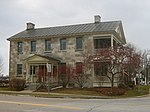Sand Bar State Park
1933 establishments in VermontCivilian Conservation Corps in VermontHistoric districts on the National Register of Historic Places in VermontLake ChamplainMilton, Vermont ... and 5 more
National Register of Historic Places in Chittenden County, VermontParks on the National Register of Historic Places in VermontProtected areas of Chittenden County, VermontState parks of VermontUse mdy dates from August 2023
Sand Bar State Park is a 15-acre (6.1 ha) state park in Milton, Vermont on the shore of Lake Champlain. The park was established in 1933.
Excerpt from the Wikipedia article Sand Bar State Park (License: CC BY-SA 3.0, Authors).Sand Bar State Park
U.S. Route 2,
Geographical coordinates (GPS) Address Nearby Places Show on map
Geographical coordinates (GPS)
| Latitude | Longitude |
|---|---|
| N 44.62709 ° | E -73.23985 ° |
Address
U.S. Route 2
Vermont, United States
Open on Google Maps







